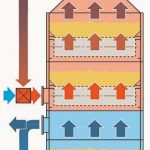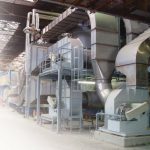If dry solid matter needs to be produced from a moist residue for further processing, it is not only the removal of moisture that plays an important role. The adjustment of certain physical and chemical properties which can decisively influence the further use of the dry product is equally critical. In addition to process reliability and efficiency, the Kahl belt drier offers the advantage of gentle product treatment and a design that can be adapted to each individual product.
Michael Gursch
When domestic or commercial waste is recovered, for example, plastic fractions or wood components must be dried to a defined residual moisture content, so that they can subsequently be compacted or pelletised. Particularly when plastic fractions are dried, it is often vital to maintain a specific drier inlet air temperature (usually less than 90 °C). The conditioned products can then be returned to the production cycle. The drying process sometimes includes a belt drier, offering the inestimable advantage of gentle and efficient product treatment.
Modular design
In the last few years, Kahl has designed and commissioned several belt drying plants on behalf of the disposal and recycling industry. The main emphasis has usually been on achieving a product quality that is suitable for recycling or disposal. Kahl belt driers have a modular design and can be combined with cooling decks or final cooling compartments. In addition, circulating air systems reduce emissions and heat losses regardless of whether drying and cooling are separate or combined. The circulating air flow rates are adjustable. Thanks to this modular design, the belt system can be easily retrofitted or extended in case of future modifications to the drying parameters. The parameters necessary to design a belt drying plant typically encompass the type of product, the throughput or evaporation capacity, the temperature, the inlet and outlet moisture, the condition of the process air and the type of heating. The retention time of the product to be dried or cooled is determined by the belt length and the speed range of the drive. By reducing the process speed, sensitive products can be handled more carefully. Mechanical stress is only exerted on the bulk product when it is transferred from one drier deck to the next, but not during the drying process itself. Drying and cooling are based on the cross and counter-current principle. The drying or cooling inlet air flows through the product from below perpendicular to the direction of the conveyor belts. As a result, heat is exchanged between this product and the air, and water is removed from it.
Flexible applications
The conveyor belt in the drier or cooler consists of slotted plates, which are screwed to the lateral conveying chains and thus easily replaceable. As the fines in the product fall through the slots, they are conveyed to a separate outlet by brushes before being discharged. These fines can be either returned to the production process or disposed of. Fabric belts can also be used to convey the product to be dried instead of slotted plates if it is very fine-grained. Various devices are available for feeding the product into the belt drier/cooler. Swivel boxes, bed depth weirs and swivel screws can be used for relatively insensitive products. Swivel chutes and swivel belts are better for more sensitive types.
Drying is a very energy-intensive process. Only a drier or belt drier optimised for the product in question is capable of operating with minimal energy input. In view of the enormous diversity of potential applications along with the quality requirements to be met by the dried product, many different drying and cooling designs are implemented. The open and closed-loop controls employed for the drying air also vary considerably according to the product.
cpp 459
More information on the manufacturer
Market place for sewage & waste technology
Share:








